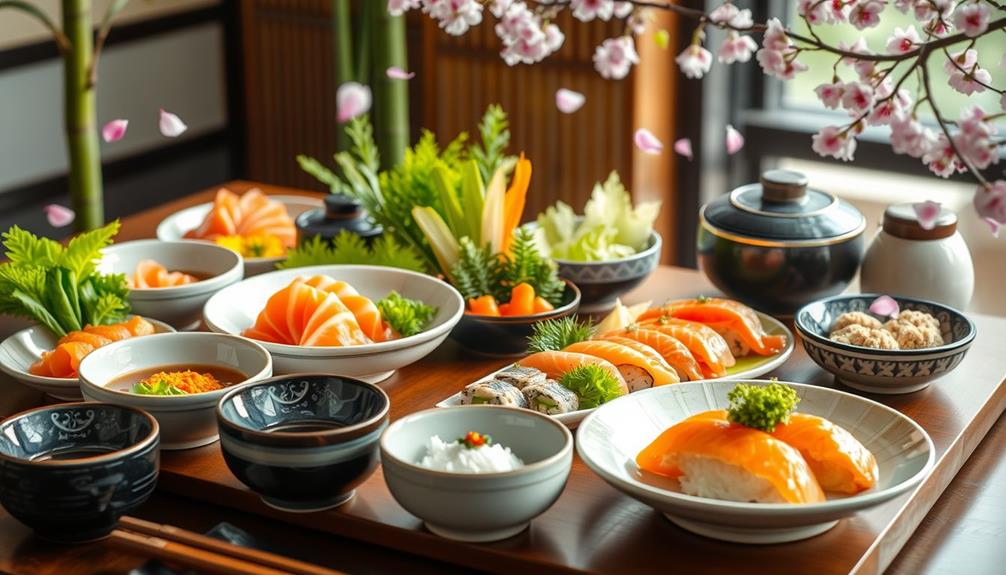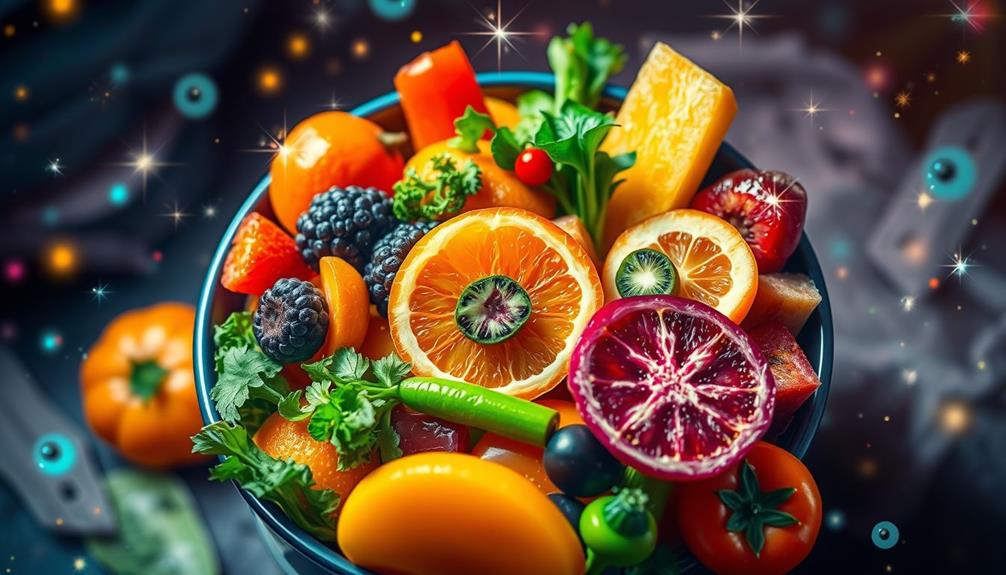You'll find that Japanese people embrace raw food for cultural, historical, and health reasons. Rooted in traditions dating back centuries, raw dishes like sushi and sashimi showcase a commitment to freshness and quality. Culinary techniques and precise presentation highlight the art of food in Japan. Religious beliefs also play a role, emphasizing purity and clean eating. Plus, the health benefits of raw seafood, such as omega-3 fatty acids, make it a nutritious choice. This reverence shapes how raw flavors and textures are celebrated. Keep exploring, and you'll uncover even more fascinating insights about this culinary passion.
Key Takeaways
- Japanese cuisine emphasizes freshness and quality, making raw fish dishes highly valued for their delicate taste and firm texture.
- Cultural beliefs in purity, rooted in Shintoism and Buddhism, promote the consumption of fresh, raw ingredients over red meat.
- Seasonal ingredients are prioritized, aligning with traditions that celebrate nature's bounty and enhance the flavors of raw fish.
- Meticulous preparation and presentation techniques elevate raw fish dishes to art forms, showcasing craftsmanship and aesthetic appeal.
- Raw fish consumption is linked to health benefits, including omega-3 fatty acids, reinforcing its popularity in Japanese dietary habits.
Historical Context of Raw Food
When you explore the historical context of raw food in Japan, you'll find that its roots stretch back to the Nara era, where evidence of raw fish consumption highlights its deep cultural significance. During this time, raw fish began to hold a prominent place in Japanese cuisine, setting the stage for its evolution.
The emphasis on fresh and pure foods aligns with traditional dietary practices, much like the considerations we see in cold medications overview, where the selection of quality ingredients is vital for health.
As you dive deeper into the Muromachi Period, you'll discover early forms of sushi, where fish was preserved inside baked rice. This innovative technique showcased the importance of raw fish, paving the way for future culinary developments.
The Edo Period marked a significant transformation when sushiman Hanaya Yohei popularized the practice of using fresh fish, making sushi a staple in urban dining.
Moreover, traditional beliefs in Shintoism and Buddhism influenced dietary choices, favoring pure and fresh foods, particularly seafood over red meat. This cultural inclination reinforced the status of raw fish as a delicacy.
Historically, raw fish consumption also tied into celebrations and special occasions, reflecting its esteemed position within Japanese culinary traditions. This rich historical context underscores why raw food, especially raw fish, remains integral to Japan's food culture today.
Culinary Preferences in Japan
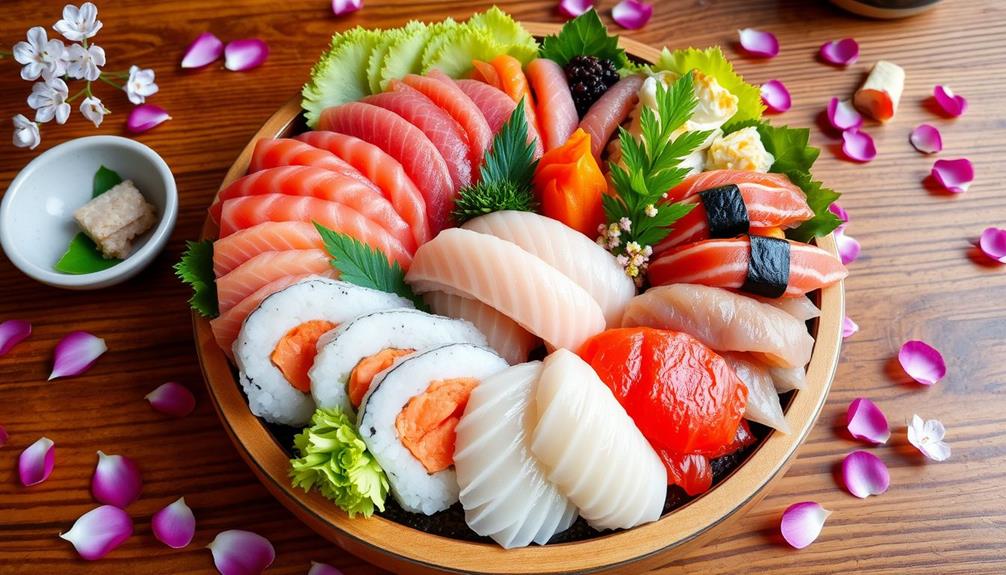
When you explore Japanese cuisine, you'll quickly notice the emphasis on freshness and quality, especially with raw fish. This cultural inclination towards raw food can be likened to the meticulous brewing methods found in coffee culture, where the appreciation for the finest ingredients is paramount, such as the various brewing methods that affect flavor and aroma.
Its unique texture and flavor make dishes like sushi and sashimi stand out as cultural delicacies. This appreciation for raw ingredients reflects a deep-rooted connection to nature and seasonal produce in Japan.
Freshness and Quality Importance
Japanese cuisine's emphasis on freshness and quality is evident in its raw food dishes, particularly sushi and sashimi. The foundation of these dishes lies in the freshness of the ingredients, especially raw fish, where the quality notably impacts taste and texture.
When you indulge in sushi or sashimi, you'll notice that the fish's freshness is paramount. High-quality fish boasts clear eyes, bright red gills, and firm flesh, all key indicators of its suitability for consumption. The use of fresh ingredients mirrors the principles found in practices like essential oils for respiratory health, where quality is vital for achieving the desired effects.
The Japanese culinary philosophy prioritizes seasonal ingredients, ensuring you savor raw fish at its peak freshness. This commitment to quality enhances your overall dining experience, as each bite reflects the care taken in selection and preparation. Precise slicing techniques and thoughtful presentation elevate both the flavor and the visual appeal of the dishes.
Moreover, cultural beliefs in the purity of fresh foods resonate with Shinto and Buddhist traditions, reinforcing the preference for raw fish. This celebration of nature's bounty not only highlights the importance of freshness but also aligns deeply with the values embedded in Japanese food culture.
Unique Texture and Flavor
The unique texture and flavor of raw fish create an extraordinary dining experience that sets Japanese cuisine apart. When you indulge in sushi and sashimi, you're not just enjoying a meal; you're experiencing the delicate taste and firm texture that raw fish offers. This culinary preference is deeply embedded in Japanese culture, where the appreciation for freshness and the natural flavors of seafood reigns supreme.
The emphasis on high-quality ingredients aligns with the principle of content quality and topical authority, reflecting a cultural commitment to excellence in food preparation.
In Japan, each bite of raw fish reflects a strong connection to seasonal ingredients and the sea. Sushi chefs meticulously select fish from local markets, prioritizing quality to guarantee that every piece is ideal in taste and texture. This emphasis on freshness transforms dining into an art form, where the presentation enhances the overall experience.
Moreover, the aesthetics of raw fish play a significant role in Japanese culture. Each dish is crafted to delight the senses, not just through flavor but also through visual appeal.
You'll find that the combination of taste, texture, and presentation makes raw fish a standout choice, embodying the essence of Japanese culinary traditions. So, when you savor sushi and sashimi, you're truly engaging in a rich cultural experience.
Raw Fish Cultural Delicacies
There's something truly special about how raw fish dishes like sushi and sashimi embody Japan's culinary preferences. In Japanese food culture, the emphasis on fresh ingredients is paramount, and raw fish perfectly showcases this commitment to quality.
You'll notice that the texture and flavor of raw fish are often celebrated as superior, making each bite a true experience. The meticulous preparation involved also mirrors the dedication seen in Paula Deen's Wedding Highlights, where every detail is thoughtfully curated to enhance the overall experience.
Careful preparation and presentation enhance these dishes, transforming a simple meal into an art form. Cultural beliefs rooted in Shintoism elevate the consumption of pure and fresh foods, aligning seamlessly with your appreciation for raw fish.
This reverence for nature and the sea deepens your connection to the culinary traditions of Japan. Historically, sushi evolved from preservation methods to a celebrated delicacy, highlighting the significance of raw fish in Japanese food culture.
It's often reserved for special occasions, showcasing the skill and craftsmanship involved in its preparation. When you enjoy a beautifully crafted dish of sashimi or sushi, you're not just tasting food; you're savoring centuries of tradition, dedication to freshness, and the rich tapestry of flavors that make Japanese cuisine so unique.
Religious Influences on Diet
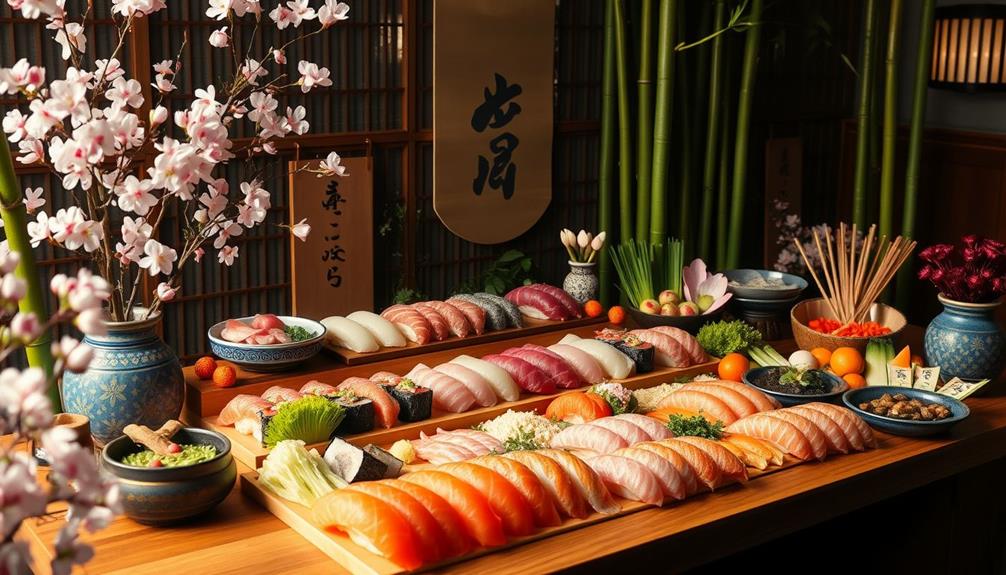
When you explore Japanese dietary habits, you'll find that religious beliefs play a significant role.
Shintoism emphasizes purity and freshness, which naturally aligns with a preference for raw foods. This cultural inclination is further supported by the traditional Japanese diet, which often includes a variety of fresh vegetables and fish, reflecting the values of balanced diet rich in fruits, vegetables, and whole grains.
Meanwhile, Buddhist teachings discourage red meat, reinforcing seafood as a primary protein source in Japanese cuisine.
Shinto Purity Beliefs
Rooted deeply in Shintoism, purity beliefs greatly shape dietary preferences in Japan, particularly the fondness for raw foods. These beliefs emphasize cleanliness and harmony with nature, influencing your choice to consume fresh seafood and raw fish dishes.
You might notice that this connection manifests in several ways:
- Fresh seafood is celebrated as a symbol of purity, being seen as clean and untainted. This aligns with the broader principle of investment regulations, where careful selection is paramount.
- Raw fish dishes, like sushi and sashimi, reflect the careful selection of seasonal ingredients, which is essential in Shinto practices.
- Offerings of fresh fish are common in Shinto rituals, reinforcing the cultural significance of consuming raw foods.
- The avoidance of red meat is influenced by the belief that blood and death are impure, steering you towards lighter, purer options.
- Seasonal ingredients are highlighted, showcasing nature's bounty and aligning with Shinto principles of respect for the environment.
Through these practices, Shinto purity beliefs not only shape what you eat but also how you connect with the food, making each meal a celebration of nature's freshness and purity.
Buddhist Dietary Practices
Buddhist dietary practices greatly influence how you approach food in Japan, with a strong emphasis on vegetarianism that often favors seafood over red meat. Rooted in the belief that consuming meat is linked to violence and death, these practices encourage a compassionate view towards living beings.
This perspective shapes a cultural preference for clean and pure foods, which aligns perfectly with the enjoyment of raw fish. Additionally, certain zodiac signs may influence personal preferences in food, suggesting that astrology can play a role in individual dietary choices, including a penchant for raw cuisine, as seen in astrological compatibility.
In many Buddhist temples, you'll find shojin ryori, a vegetarian cuisine that celebrates seasonal vegetables and grains. This connection to nature allows for the inclusion of seafood, as it's seen as a more ethical choice.
The teachings of Buddhism promote compassion, making seafood, including raw fish, a more acceptable dietary option compared to meat from land animals.
As you explore Japanese cuisine, you'll notice how these principles have woven into everyday dishes. Raw fish dishes like sushi and sashimi aren't just meals; they represent purity and a deep connection to the sea.
Societal Attitudes Towards Raw Fish
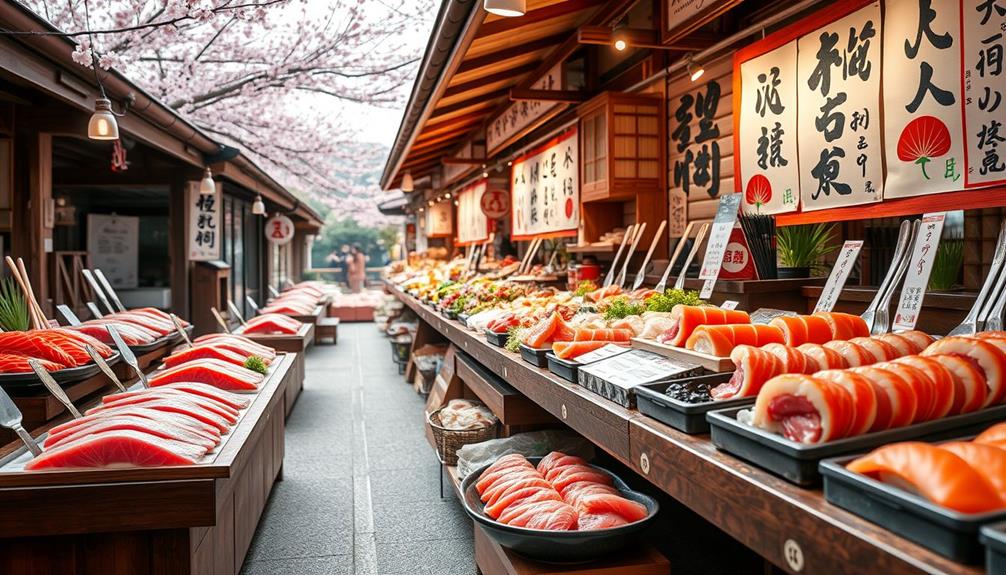
In Japan, there's a deep-seated reverence for raw fish that shapes societal attitudes towards its consumption. This isn't just about flavor; it's woven into the very fabric of Japanese food culture.
The preference for raw fish over red meat stems from cultural beliefs that view butchers and hunters as impure, reinforcing a mindset that favors seafood as a cleaner, healthier alternative. Additionally, the health awareness surrounding raw fish is enhanced by its rich nutritional profile, which includes beneficial omega-3 fatty acids that contribute to overall wellness and may align with juice diet considerations regarding the importance of balanced nutrition.
You might notice these key aspects when exploring the societal attitudes:
- Seasonal Emphasis: Freshness and seasonal ingredients are celebrated, reflecting respect for nature.
- Culinary Experience: Sushi bars and izakayas offer communal dining, enhancing appreciation for raw fish dishes.
- Delicacy Status: Many Japanese people indulge in raw fish only a few times a year, treating it as a special delicacy.
- Health Awareness: Growing knowledge about the health benefits, like omega-3 fatty acids, boosts raw fish's appeal.
- Cultural Tradition: Raw fish consumption is rooted in centuries of tradition, making it a significant part of Japanese identity.
These elements illustrate how raw fish is more than just food; it's an integral part of the Japanese way of life.
Health Benefits of Raw Seafood
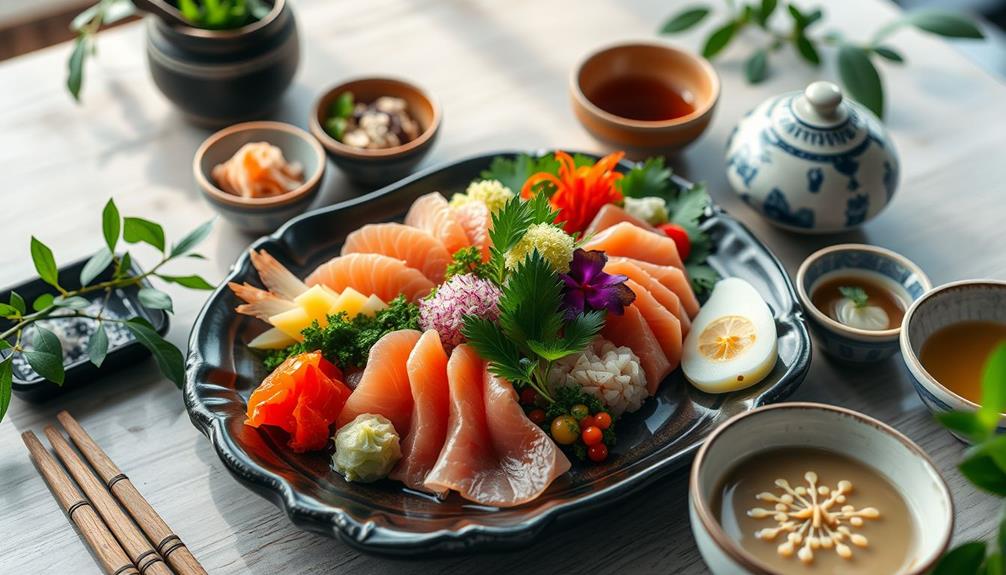
The appreciation for raw fish in Japan goes beyond taste; it's also tied to significant health benefits that contribute to its popularity. When you indulge in raw seafood, you're enjoying a powerhouse of omega-3 fatty acids, which are essential for improving heart health and reducing the risk of cardiovascular diseases.
In addition, raw fish offers high-quality protein, essential for muscle maintenance and repair, making it a nutritious choice in a balanced diet. Moreover, the consumption of fish may also be linked to lower risks of various health issues, including breast cancer symptoms, further enhancing its nutritional profile.
One of the standout features of raw seafood is its low saturated fat content compared to cooked meats. This aspect promotes healthier dietary options and aids in weight management. Additionally, studies link the consumption of raw fish to lower rates of certain chronic diseases, further enhancing its appeal within Japanese cuisine.
Preparation and Presentation Techniques
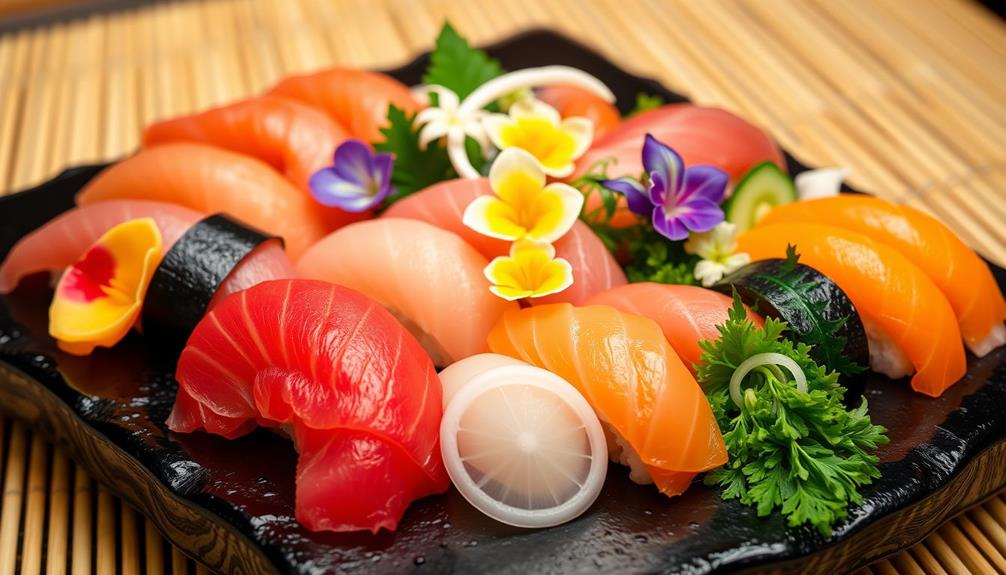
Mastering the preparation and presentation of raw fish in Japanese cuisine requires a blend of skill and artistry. You must pay close attention to every detail, ensuring the fish is fresh and beautifully arranged. This meticulous process not only enhances flavor but also elevates the dining experience.
Here are some key techniques to keep in mind:
- Precise slicing: Using high-quality knives, crafted with traditional methods, you can achieve clean cuts that highlight the fish's texture.
- Fresh sourcing: Fish is typically sourced from local markets and prepared on the same day, ensuring ideal taste and safety.
- Aesthetic arrangement: Pay attention to color and texture when plating sashimi, as visual appeal is essential.
- Accompaniments: Incorporating soy sauce and wasabi not only enhances flavor but also provides antibacterial properties.
- Cultural elements: Presentation often reflects a connection to nature, showcasing the harmony between the sea and the dish.
Global Influence of Japanese Cuisine
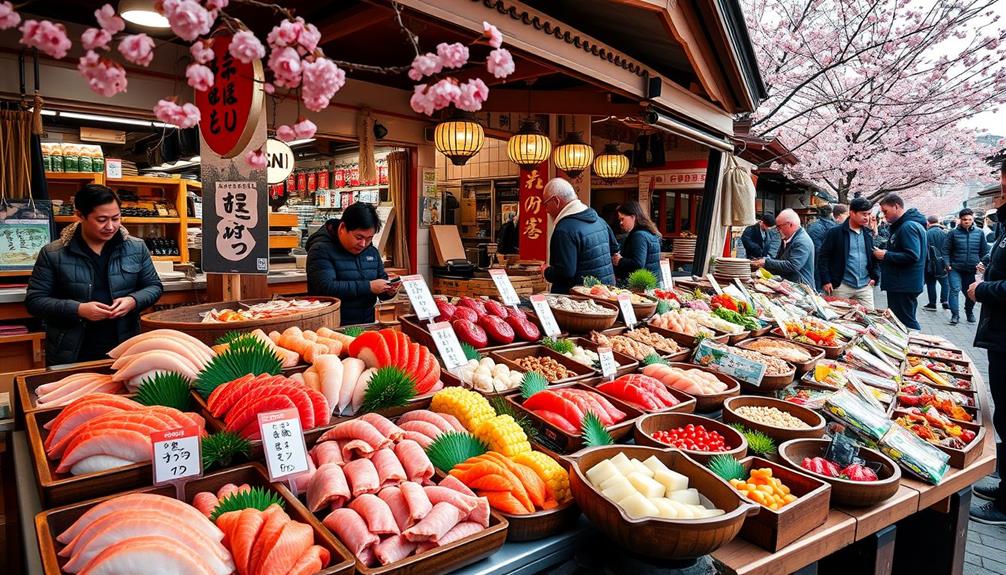
Japanese cuisine has taken the world by storm, enchanting taste buds and inspiring culinary trends across the globe. Sushi and sashimi, with their emphasis on fresh fish and delicate preparation, have become staples in cities from New York to Paris.
You've likely noticed a sushi bar on almost every corner, highlighting the widespread appreciation for these dishes.
The concept of umami, a key element in Japanese cooking, has reshaped how many people think about flavor, leading to a deeper appreciation for taste in various cuisines.
Additionally, the principle of seasonal eating, rooted in Japanese culture, encourages conscious consumers to seek fresh, local ingredients, influencing culinary practices worldwide.
You may have even tried innovative fusion dishes like sushi burritos or sushi burgers, which showcase the adaptability of Japanese flavors to modern tastes.
As culinary tourism grows, more individuals are exploring traditional Japanese cooking techniques and ingredients, further embedding this rich food culture into global culinary practices.
This global influence not only celebrates Japanese cuisine but also fosters a greater understanding of its cultural significance and culinary artistry.
Frequently Asked Questions
Why Do Japanese People Like Raw Food?
You'll find that Japanese people appreciate raw food for its fresh flavors, unique textures, and health benefits. They enjoy the artistry in presentation and the cultural ties to purity, making raw dishes a beloved culinary choice.
Why Is Food Important to Japanese Culture?
Food's important in Japanese culture because it connects you to nature and seasonal changes. You appreciate the artistry in preparation, share meals with loved ones, and participate in rituals that emphasize harmony and respect for traditions.
Why Is Sushi Important to Japanese Culture?
Sushi symbolizes Japan's harmony with nature, showcasing seasonal ingredients and meticulous craftsmanship. You'll find it embodies cultural identity, fostering community bonds in restaurants, while celebrating the beauty and simplicity of life's fleeting moments through food.
Why Do Japanese People Like Sushi so Much?
You enjoy sushi for its fresh flavors and the artistry behind its preparation. The communal experience of sharing sushi with family and friends enhances your appreciation, making it not just food, but a cherished tradition.
Conclusion
So, next time you find yourself eyeing a plate of sushi, remember: it's not just food; it's a cultural masterpiece! While you might be wondering if raw fish is a daring culinary adventure or just a health hazard, the Japanese have nailed it for centuries. Who needs a hot stove when you've got centuries of tradition and a dash of daring to back you up? Bon appétit—or should we say, "Sushi, the way to go!"

